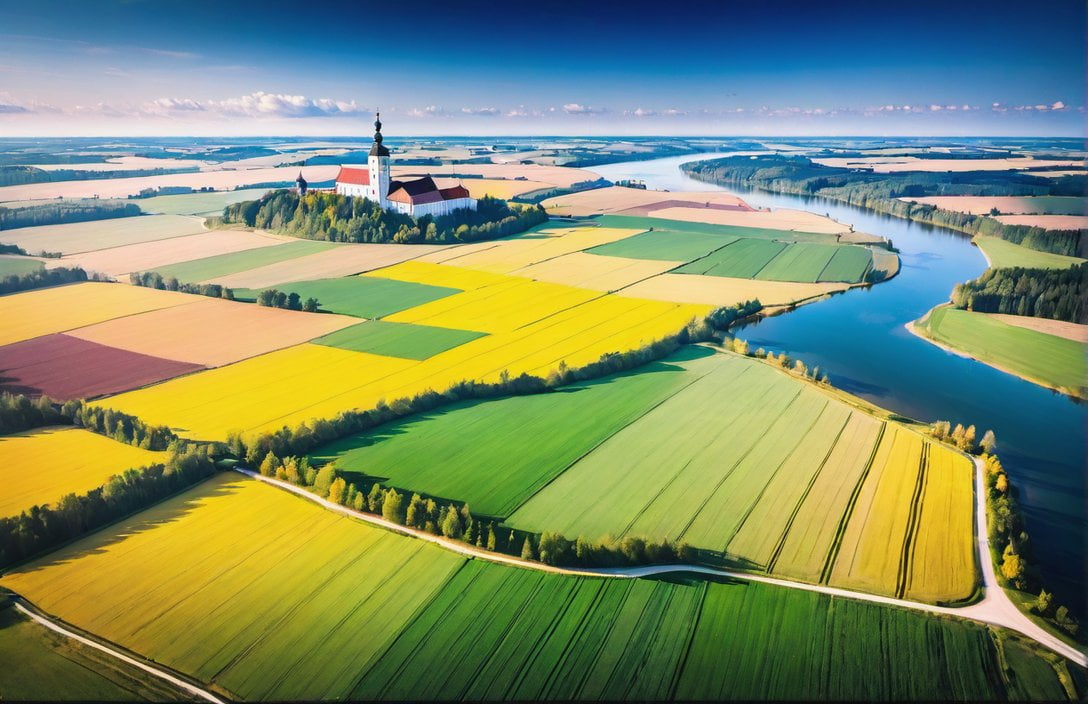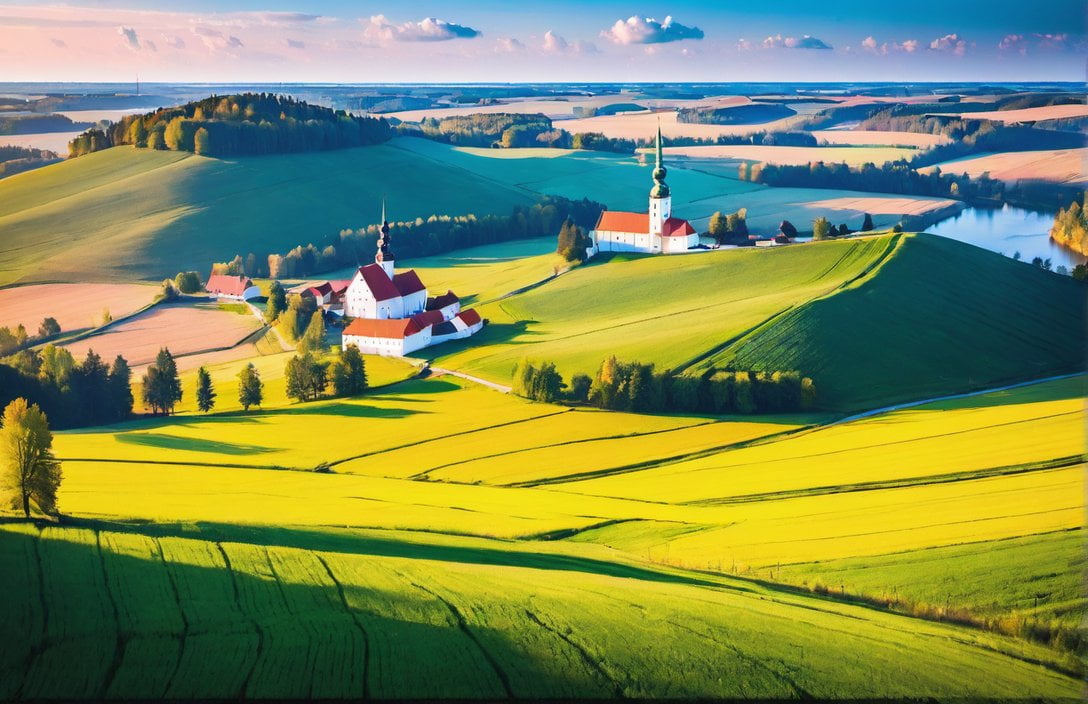Lithuania, with its rich history, vibrant traditions, and breathtaking landscapes, is a country that beckons exploration. A land of fascinating facts and hidden treasures, it is home to renowned composer Mikalojus Konstantinas ?iurlionis and boasts the only national museum dedicated to the history of genocide. Its beautiful castles stand as testaments to its past, while its membership in the European Union and NATO showcases its place on the global stage. Join us on a journey as we delve into the fascinating facts about Lithuania, unveiling its history, traditions, and vibrant landscapes.

Key Takeaways:
- Lithuania was the first Soviet state to declare independence in 1990, marking a significant historical event that had far-reaching consequences for the region.
- Lithuania’s membership in the European Union and NATO has solidified its position on the international stage and strengthened its ties with neighboring countries.
- The official language of Lithuania is Lithuanian, which reflects the country’s rich cultural heritage and identity with its ancient Baltic roots.
- Vilnius, the capital city of Lithuania, is renowned for its impressive Old Town recognized as a UNESCO World Heritage Site, featuring stunning baroque architecture and a charming atmosphere.
- The Curonian Spit, located along the coast of the Baltic Sea, is home to the largest dunes in Europe, offering breathtaking views and diverse ecosystems, making it a popular destination for nature enthusiasts.
Facts About Lithuania
Lithuania, a historical gem and natural wonder in Northern Europe, offers a fascinating blend of history, traditions, and vibrant landscapes that captivate visitors from around the world. Let’s dive into some intriguing facts about Lithuania, shedding light on its significance, culture, landmarks, and natural wonders.
1. Independence and Soviet Legacy
Lithuania made history by being the first Soviet state to declare independence in 1990. This pivotal event not only shaped the country’s future but also had far-reaching consequences for the entire region. The courage and determination of the Lithuanian people in reclaiming their sovereignty set a powerful precedent for other nations.
2. Membership in European Union and NATO
As a proud member of the European Union and NATO, Lithuania has firmly established itself as an active participant in global affairs. This membership not only strengthens Lithuania’s ties with neighboring countries but also amplifies its voice on the international stage. The country’s active engagement in these organizations demonstrates its commitment to peace, stability, and cooperation.
3. Official Language and Cultural Heritage
Lithuania treasures its rich cultural heritage, and the official language, Lithuanian, is a testament to this. Spoken by more than 82% of the population, Lithuanian is an ancient Baltic language known for its distinctive features and archaic elements. Preserving and celebrating this language symbolizes the country’s deep-rooted cultural identity.
4. Capital City and Historic Old Town
Vilnius, the captivating capital city of Lithuania, showcases a treasure trove of history and architectural marvels. Its historic Old Town, recognized as a UNESCO World Heritage Site, beckons visitors with its baroque architecture, cobbled streets, and enchanting atmosphere. Exploring the winding alleys and experiencing the vibrant local culture is an absolute must for anyone visiting Lithuania.
5. Natural Wonders: The Curonian Spit
Lithuania’s natural beauty shines through the awe-inspiring Curonian Spit. Stretching along the coast of the Baltic Sea for 98 kilometers, this mesmerizing natural wonder boasts the largest dunes in Europe. Its pristine beaches and lush forests present a harmonious blend of ecosystems, making it a haven for nature enthusiasts. The sweeping vistas and tranquility of the Curonian Spit leave an indelible mark on all who visit.
These are just a few of the fascinating facts about Lithuania, a country that seamlessly weaves together its historical significance, vibrant culture, and breathtaking landscapes. From its journey to independence to its participation in international organizations, Lithuania continues to make its mark on the global stage. Whether you’re exploring the architectural wonders of Vilnius or immersing yourself in the natural splendor of the Curonian Spit, Lithuania offers a captivating experience like no other.
Sources:
- Facts about Lithuania – 10 Fascinating Facts
- Lithuania Facts for Kids
- 27 Fascinating Facts About Lithuania: Discover the Baltic Gem
If you want to uncover fascinating facts about Samoan culture, click here to dive into the world of Samoan heritage.
For a fun-filled exploration of Lithuania, including its rich history and traditions, check out these amazing Lithuania fun facts here.
Discover intriguing facts about Tasmania’s unique wildlife, stunning landscapes, and rich history by clicking here.
To learn more about the fascinating culture and history of Lithuanians, click here and delve into the world of this extraordinary Baltic nation.
Unveil interesting facts about Lithuania’s traditions, landmarks, and cuisine by clicking here and exploring this enchanting European destination.
Lithuania is known for its beautiful castles.
Trakai Island Castle: A Picturesque Island Citadel
Trakai Island Castle stands as a testament to Lithuania’s medieval history and is a must-visit destination for castle enthusiasts. Situated on a picturesque island in Lake Galve, this castle is the only insular castle in all of Europe. Its stunning beauty and unique location make it a favorite among photographers. The red-brick architecture of the castle reflects beautifully in the surrounding water, creating a mesmerizing sight to behold.
Gediminas’ Tower: A Historical Icon
Gediminas’ Tower, located in Vilnius, is a symbol of Lithuania’s rich history and cultural heritage. As part of the Vilnius Castle Complex, this tower offers panoramic views of the city’s skyline and the enchanting surroundings. The castle itself holds immense historical significance, as it was the residence of Lithuanian grand dukes. Visitors can explore the tower and immerse themselves in the captivating stories of the past.
Vilnius Castle Complex: An Architectural Marvel
Vilnius Castle Complex is a treasure trove of architectural wonders. This complex comprises several buildings, including the Gediminas’ Tower, Upper Castle, and remaining fortifications. The red-brick structures beautifully showcase the country’s architectural heritage. Taking a leisurely stroll through the complex, visitors can soak in the unique blend of old-world charm and contemporary vibrancy that Lithuania exudes.
Kaunas Castle: The Oldest Castle in Lithuania
Among the impressive array of castles in Lithuania, Kaunas Castle takes the crown as being the oldest. Built in the 14th century, this castle played a vital role in defending the country from invaders. It is mentioned in print publications from 1361, solidifying its historical significance. Beyond being a historic landmark, Kaunas Castle is a living testament to Lithuania’s resilience and enduring spirit.
The Enchanting Hill of Crosses
The Hill of Crosses is a truly enchanting sight that holds deep religious and cultural significance in Lithuania. For over a century, millions of pilgrims have erected hundreds of thousands of crosses on this hill, creating a unique and spiritual atmosphere. The Hill of Crosses stands as a symbol of faith, hope, and unity, making it a powerful testament to Lithuania’s cultural identity.
Key Takeaways:
- Lithuania boasts a rich collection of beautiful castles, including Trakai Island Castle, Gediminas’ Tower, Vilnius Castle Complex, and Kaunas Castle.
- Trakai Island Castle is a picturesque island citadel, the only insular castle in all of Europe, and renowned for its red-brick architecture reflecting in the surrounding water.
- Gediminas’ Tower, part of the Vilnius Castle Complex, offers panoramic views of Vilnius and embodies Lithuania’s historical legacy.
- Vilnius Castle Complex showcases a stunning blend of old-world charm and contemporary vibrancy, with its red-brick structures and historical significance.
- Kaunas Castle, dating back to the 14th century, is the oldest castle in Lithuania and speaks to the country’s enduring spirit.
- The Hill of Crosses is a unique and spiritual site, representing faith, hope, and unity in Lithuania.
Sources:
– Travel Safe – Abroad: Link to the website
– Meet Me In Departures: Link to the website
Lithuania is a member of the European Union and NATO.
Key Takeaways:
– Lithuania is a developed country with a high income and advanced economy, ranking 35th in the Human Development Index.
– The country joined the European Union on May 1, 2004, and adopted the euro as its currency on January 1, 2015.
– Lithuania is a member of the European Union, Council of Europe, eurozone, and NATO, providing unique economic and political opportunities.
– The population of Lithuania is approximately 2.8 million people, with Lithuanian being the official language spoken by around 3 million people.
– Vilnius serves as both the capital and the largest city in Lithuania.
– Famous landmarks in Lithuania include the Vilnius Old Town, Trakai Castle, and the Hill of Crosses.
– Lithuania is an active member of the Nordic-Baltic Eight regional cooperation format and has been a member of NATO since March 29, 2004.
Lithuania, a small but vibrant Northern European country, boasts a wealth of intriguing facts that make it an alluring destination for travelers and a noteworthy subject for exploration. With its membership in the European Union and NATO, Lithuania holds a crucial position on the global stage, ensuring stability and advantageous opportunities for its citizens.
As a member of the European Union, Lithuania enjoys the benefits of being part of a cohesive economic and political entity. The country joined the European Union on May 1, 2004, marking a significant milestone in its history and opening doors to various advantages. One such advantage is the adoption of the euro as its currency on January 1, 2015. This move streamlined trade and financial transactions, further solidifying Lithuania’s economic stature.
Home to a population of approximately 2.8 million people, Lithuania thrives under its official language, Lithuanian, spoken by around 3 million individuals. This linguistic unity contributes to the country’s cultural heritage and strengthens its identity. At the heart of Lithuania lies its capital city, Vilnius, which not only serves as a political center but also boasts a rich historical and architectural tapestry. From the narrow cobblestone streets of the Vilnius Old Town to the grandeur of Trakai Castle and the spiritual significance of the Hill of Crosses, Lithuania’s landmarks are captivating symbols of its past and present.
Lithuania’s active involvement in regional cooperation formats such as the Nordic-Baltic Eight (NB8) showcases its commitment to collaboration and diplomacy. Through this regional alliance, Lithuania strengthens its ties with Nordic countries and fellow Baltic states, collectively working towards shared goals and mutual benefits.
Perhaps one of the most significant aspects of Lithuania’s international participation is its membership in NATO. Since March 29, 2004, Lithuania has been a full-fledged member, assuming all the obligations and security guarantees provided by the alliance. This membership not only ensures Lithuania’s security but also establishes close ties with other NATO states, fostering cooperation and creating a united front against potential threats.
In conclusion, Lithuania’s presence as a member of the European Union and NATO speaks volumes about its standing on the global stage. With a developed economy, a rich cultural heritage, and a commitment to regional cooperation and security, Lithuania emerges as a fascinating country that combines historical charm with contemporary dynamism.
Sources:
– Wikipedia
– Lithuania: Key Facts

FAQ
Q1: Is Lithuania the homeland of the famous composer Mikalojus Konstantinas ??iurlionis?
A1: Yes, Lithuania is the homeland of the famous composer Mikalojus Konstantinas ??iurlionis. He is renowned for his symphonic poems, piano works, and paintings that combine music and visual art.
Q2: Does Lithuania have a national museum dedicated to the history of genocide?
A2: Yes, Lithuania is home to the only national museum dedicated to the history of genocide. The Museum of Occupations and Freedom Fights in Vilnius showcases the tragic history of occupation and oppression that Lithuania endured under Soviet and Nazi regimes.
Q3: Is Lithuania known for its beautiful castles?
A3: Yes, Lithuania is known for its beautiful castles. Castles like Trakai Island Castle, Gediminas’ Tower, and Vilnius Castle Complex are prominent examples of Lithuania’s rich history and architectural heritage.
Q4: Is Lithuania a member of the European Union and NATO?
A4: Yes, Lithuania is a member of both the European Union and NATO. Its membership in these organizations has strengthened its ties with neighboring countries and solidified its position on the international stage.
Q5: What are some of the famous landmarks in Lithuania?
A5: Lithuania is home to several famous landmarks, including the Vilnius Old Town, a UNESCO World Heritage Site known for its baroque architecture and charming atmosphere. Trakai Castle, located on Lake Galve, is another notable landmark, famous for being the only insular castle in Europe. The Hill of Crosses is also a famous sight in Lithuania, where millions of pilgrims have erected hundreds of thousands of crosses over the years.
















